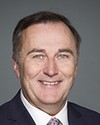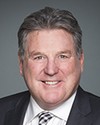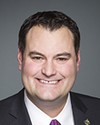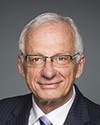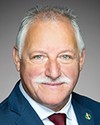Thank you for having me, sir.
In Houston here, obviously we've had a bit of trouble with a hurricane, if you haven't heard, and it's brought up this idea of resilience and what a resilient city would look like. Although we bounced back very quickly in terms of hurricane recovery, and everyone is back to work and everyone is housed, we found that the veteran community was one of the major things that led the resilience of our city in the return to normalcy after the hurricane. That fit in line with everything we designed when we built the Combined Arms system.
I come from the United States Marine Corps. I worked in the United States Congress as a military liaison, and then worked at the municipal level to build the Houston-Harris County returning veterans initiative, which was led by our then mayor and county judge in a collaborative effort. Being an entity of municipal government, we ceilinged out very quickly and realized that creating one program can't address all of the complex needs and issues of the entire veteran community, the second-largest of which in the United States is in our area, smaller only than the community in Los Angeles.
So we set out to create another program, through the United Way, which is a very institutional NGO here in the United States. The United Way set up a 211 hotline for veterans, so they could be directed to resources. We quickly found out that only elderly veterans and veterans who use the phone instead of the Internet were actually accessing these resources. We were missing the entire transitioning military and post-911 Iraq and Afghanistan populations and their families.
Then we set up another program, after ceilinging out yet a second time, called the Lone Star Veterans Association. That was meant to recreate that network of camaraderie that we enjoy in the military and be kind of a net to catch all of the returning Iraq and Afghanistan veterans and their families, and to ensure that they make that successful transition from military to civilian life.
Yet again, because it was another program, we ceilinged out very quickly. It took us eight years to make those mistakes and to figure out that we can't just create another program to find a solution to the complex needs and problems in the veteran community. We needed to create a system of programs that connected all of the government agencies, the NGOs, and the private organizations that have a stake in military transition and veterans affairs.
That's when we created the Combined Arms system. Some of the data points we used when we created this system were backed by the University of Southern California and their survey on the state of the American veteran. There's another one out of Cincinnati that Deloitte backed, which basically showed findings and recommendations. It showed that veterans are unprepared, obviously. We all know that. How do we address that problem? Should we conduct an awareness campaign that targets veterans and their families to make sure they're connected to resources?
One organization really can't address all the issues. For so long, people believed that the United States Department of Veterans Affairs was the solution in terms of veteran transition. In fact, they provide only three services: health care delivery, benefits administration, and cemetery administration. They technically cannot be—because we have such a limited government—everything to everyone. We needed to establish a community support network that really addressed veterans issues in a holistic way, and held these agencies more accountable to ensure that these veterans didn't fall through the cracks and that we weren't getting bogus organizations joining our network.
The organizations themselves were disjointed. Organization A and organization B didn't know what one another did, and they certainly didn't know how to properly refer to one another. That's why we created our integrated technology system to develop that collaborative accelerator, to ensure that we lower the overhead and reduce programmatic redundancies when veterans enter the system, either electronically or physically.
Finally, one of the last findings and recommendations that we derived from all of our research is that data is not consistent, nor is it shared. If we're able to standardize this data capture and share it across the networks and the community, we can use that to identify redundancies, lower the overhead, and also go for more consistent funding in a collaborative way.
Our mission in Combined Arms as a backbone organization here in the Houston area is to unite the community to accelerate the impact of veterans in Houston. We're not serving veterans. We're not helping veterans. We don't have the traditional mission statements that have operation and heroes and all kinds of weird terminology in there. We're actually here to accelerate their impact, accelerate their transition, so that they can make a more significant economic and social impact on the communities they return to, particularly here in southeast Texas.
Our three major strategic objectives are to create a system and to really establish and nurture the system of organizations that provide holistic services and support. We're built on efficiency, as I said, so we want to reduce those programmatic redundancies and costs, and make sure we're serving veterans quickly and effectively. Collaboration is at the core of everything we do, so we want to increase the collaboration of organizations and also increase the quality of services. We do that in really four different ways. We have a transition centre. We have a physical single point of entry for our large community. We're the third-largest city in the United States; Chicago will argue that it's third, but if we actually count our undocumented population, then we're definitely the third, and the 2020 census will absolutely show that.
Our transition centre is centrally located. It's available via the rail line and the bus line. It has free parking, a café, and a gym. It really serves as not only a co-working space for our organizations to collaborate more effectively but also really that one single point of entry, that one-stop shop, so to speak, for transitioning service members and post-9/11 veterans and their families to access so they can be served not just by one service but, holistically, by, on average, six different services when they enter the system physically or electronically.
When I say electronically, the second way we do this is with our technology platform. It's built on Salesforce.com, which is a really innovative Fortune 500 client relationship management tool. We essentially customized that with the developer to ensure that each of the organizations has an account, and that whenever they received a referral from a veteran entering the system electronically or physically, or through one of the 40 organizations that are partners, this referral would be tracked and this organization would be held accountable. When I say held accountable, it's not that somebody's calling them to let them know that they're behind. We actually have a scoreboard that's posted here in our transition centre in the café, which holds everybody very publicly accountable, so it kind of creates this collaborative competition in which you can see each of the 40 organizations that are in this system. You can see how far behind some are and how quickly some are responding and how quickly they close the cases, and which result in positive outcomes for the veterans, be that in employment, mental health services, veterans assistance, community service, volunteering, or camaraderie, etc.
We have an integrated marketing campaign, and it's something that I think a lot of communities miss. If we collectively pool our financial resources, we can actually actively market to the active military populations on base and sell Houston as a destination, so we say, “Check out of your unit in San Diego, California, or Fort Leonard Wood, Missouri, or Norfolk, Virginia, and check into your new unit here in Houston, and we'll help you find a job, help get you housing, help your family, and help you find financial assistance and benefit services from the VA. We'll really help address everything as holistically as we can.” We're doing it almost as an economic development initiative.
Really, our value—and I'll finish with this and allow everyone to have some questions, because I know I don't have too much time, and as I said, I'm a marine, so I want to be as brief as possible—is accelerating impact through value. The veterans come in and they have an assessment. With our no-wrong-door approach, the veterans can really enter our programs through any of our 40 partner organizations or through another method that leads them to us, such as the marketing campaign or word of mouth or their transition-assistance counsellor. The value to the veterans that the Combined Arms system—which is kind of a third-party, backbone organization that connects all of these different agencies, government, non-profit, and private—offers is really speed, efficiency, accountability, and holistic support. The value we provide to our 40 member organizations is shared data, collaboration, feedback, mission focus, and free space.
When we are selling to Houston our value to the community, we show our economic impact. I actually show the average starting salary of veterans and show their economic impact, because they're buying groceries there, taking their kids to school, paying their property taxes, buying houses, and getting engaged and involved in the community and showing how much we're volunteering, because we all want to continue our service after we take off the uniform. We want to show how much we're impacting low-income and at-risk neighbourhoods in the city. With regard to social growth, we can show that veterans not only participate in civic organizations more but we tend to vote more, and we're more civically healthy, so to speak, if we have that ability to transition successfully from the front end of our service and move into civilian life.
And really, it's just getting civilians more involved. We all talk about bridging the military-civilian divide. We're really trying to bring in the community.
Today, for example, one of the big Hurricane Harvey relief efforts is brought in by Ford, the truck maker—well, it's a truck maker down here in Houston but of course a car maker everywhere else. The Houston Texans, which is our American football team, of course, are coming in and doing a lot of fanfare for all the organizations that volunteered and stepped up for the Harvey relief. So it's really getting the community involved and engaging media, engaging our politicians, and really activating those institutional NGOs like Easter Seals and United Way, and of course, getting government agencies like the VA, state or provincial government, and our municipal government activated and aware of who we serve.
I wanted to be brief because we have other presenters, but if you need to see any of our data in terms of the veterans per category of service, the number of clients, the response time in hours, or any other data showing the number of connections made this year to date and some demographic data on the veterans we serve, I'd be happy to share my screen and show that to you.
Thank you having me.

